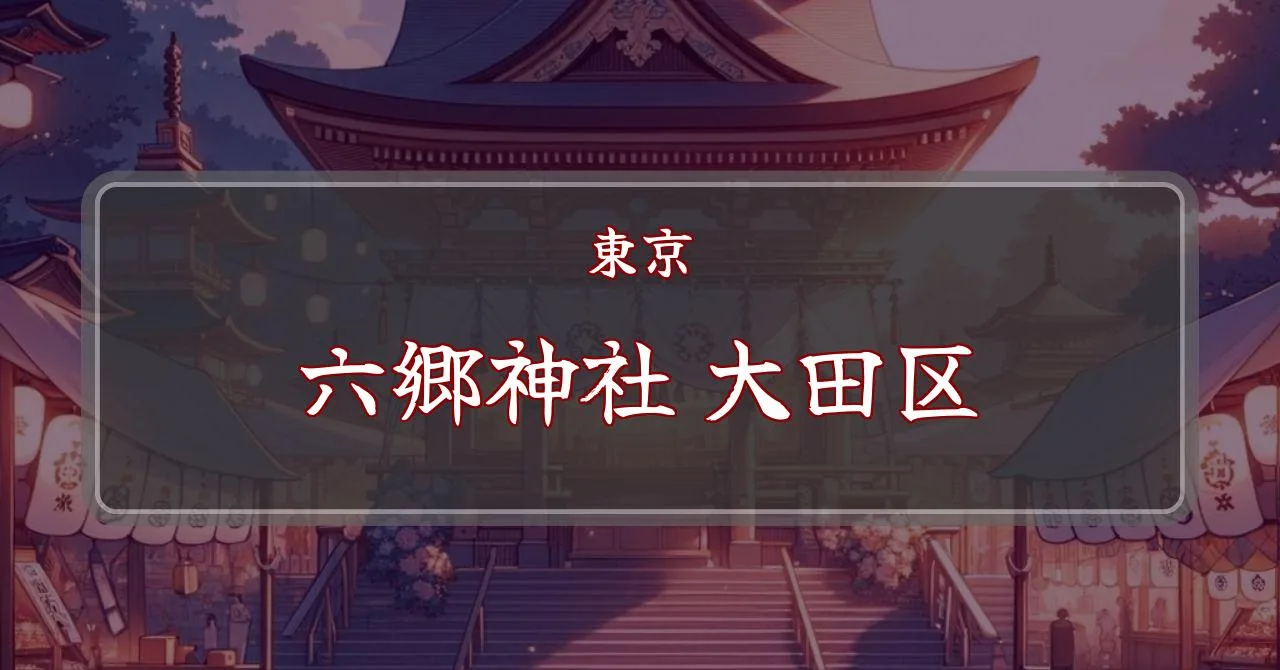2025年 六郷神社例大祭:源氏ゆかりの伝統と神輿渡御!
イベントの概要
東京都大田区の六郷神社では、2025年も例大祭が盛大に開催されます!平安時代から続く歴史を誇る六郷神社の例大祭は、地域に深く根付いた伝統行事として知られています。 神輿渡御をメインに、子供神獅子舞の奉納など、見どころ満載のイベントです。境内には250以上の露店が立ち並び、活気に満ちた賑やかな雰囲気を味わえます。5年に一度の本祭の年には、貴重な一之宮神輿が渡御します。2025年は本祭ではないため、二之宮神輿が渡御されますが、それでも迫力満点の渡御行列は必見です。 神楽殿では、江戸の里神楽ではなく横浜の社中による里神楽が奉納され、伝統芸能の粋を堪能できます。子供神獅子舞は、東京都指定無形民俗文化財にも指定されており、子供たちの真剣な姿に感動すること間違いなし。 例大祭は、地域住民だけでなく、多くの観光客も訪れる一大イベントです。歴史と伝統、そして活気に満ちた六郷神社の例大祭に、ぜひお越しください! 具体的な日程や時間は、六郷神社の公式ウェブサイトでご確認ください。
基本情報
- 開催日: 2025年6月第1金曜日~日曜日(式典は6月3日)
- 開催時間: 詳細な時間は公式ウェブサイトをご確認ください。例年、神輿渡御は日中に行われます。
- 住所・開催場所: 六郷神社
〒144-0046 東京都大田区東六郷3丁目10−18 - アクセス: 京急本線 六郷土手駅より徒歩約8分
- 問い合わせ先: 03-3731-2889 (六郷神社)
- 公式ウェブサイト: https://rokugo.or.jp
主なイベント
六郷神社例大祭は、神輿渡御を中心とした、古くから伝わる伝統的な神事と、地域住民の活気に満ちたお祭りです。 神輿渡御、子供神獅子舞、里神楽など、様々な催し物が境内を彩ります。露店も多数出店し、一日中楽しめるイベントとなっています。
神輿渡御
例大祭のハイライトは、なんといっても神輿渡御です。5年に一度の本祭の年には一之宮神輿が、それ以外の年は二之宮神輿が氏子地域を巡行します。 2025年は本祭ではないため二之宮神輿の渡御となりますが、それでも迫力満点の行列は必見です。 神輿の担ぎ手たちの力強い掛け声と、沿道からの盛大な歓迎を受けながら、地域全体が一体となって神輿を担ぎ上げます。 渡御ルートは、六郷神社の公式ウェブサイトなどで確認できます。 神輿の担ぎ方として、羽田や六郷で盛んな「ヨコタ担ぎ」も見られるかもしれません。 神輿の渡御は、地域住民にとって神様への感謝と、地域社会の結束を深める大切な儀式です。
子供神獅子舞
例大祭では、子供たちによる神獅子舞が奉納されます。 これは、東京都指定無形民俗文化財にも指定されている貴重な伝統芸能です。 3匹の獅子(牡獅子、牝獅子、中獅子)と、それを操る子供たち、そして囃子方の少女たちが織りなす、ダイナミックで可愛らしい舞は、見ている人を魅了します。 子供たちは、真剣な表情で伝統的な舞を披露し、その姿は多くの感動を呼び起こします。 神獅子舞は、氏子地域を巡行する「道行」と、神社境内の神楽殿で奉納される「辻舞い」があります。 子供たちの健やかな成長と地域の繁栄を祈念する、心温まる奉納行事です。
- 内容:牡獅子、牝獅子、中獅子による伝統的な獅子舞。子供たちが演じます。
- 特徴:東京都指定無形民俗文化財。境内での奉納と氏子地域を巡行する道行があります。
里神楽
例大祭の土日には、神楽殿で里神楽が奉納されます。 これは、横浜の社中によるもので、江戸の里神楽とは異なる特徴を持っています。 神楽独特の音楽と舞は、神聖な雰囲気を醸し出し、祭りの厳かな雰囲気を高めます。 里神楽は、神様への奉納だけでなく、地域住民の娯楽としても親しまれてきました。 伝統芸能を間近で鑑賞できる貴重な機会です。
- 内容:横浜の社中による里神楽の奉納。
- 特徴:江戸の里神楽とは異なる様式。神楽殿での奉納。
その他
例大祭期間中は、境内には250以上の露店が出店し、賑やかな雰囲気となります。 様々な食べ物が楽しめる他、おもちゃやゲームなど、子供も大人も楽しめるものがたくさんあります。 また、町神輿の渡御もあり、地域全体が一体となって祭りを盛り上げます。
アクセス方法
六郷神社へのアクセスは、公共交通機関が便利です。最寄りの駅は京急本線「六郷土手駅」で、駅から徒歩で約8分ほどです。駅からは、比較的分かりやすい道順で神社へたどり着けます。 周辺には、商店街なども整備されているため、お祭りの前後には、食事や買い物を楽しむこともできます。車での来場は、駐車場の状況によっては困難な場合もありますので、公共交通機関の利用を推奨します。
- 電車:京急本線「六郷土手駅」下車後、徒歩約8分
駐車場情報
六郷神社には、境内または近隣に駐車場がありますが、台数に限りがあります。例大祭期間中は特に混雑が予想されるため、公共交通機関の利用を強くお勧めします。 車でお越しの際は、早めの到着を心がけ、満車の場合は近隣の有料駐車場をご利用ください。
- 境内駐車場:台数に限りあり。満車の場合は近隣の駐車場をご利用ください。
- 近隣有料駐車場:いくつか存在します。詳細は、地図アプリなどでご確認ください。
その他の情報
例大祭は、屋外での開催となりますので、天候に合わせた服装でお越しください。雨天の場合でも、神事やイベントは予定通り行われることが多いですが、状況によっては変更となる可能性もあります。 また、歩きやすい靴を履いてくることをお勧めします。 持ち物については、特に指定はありませんが、水分補給のための飲み物などがあると便利です。 日差しが強い場合は、帽子や日焼け止めなどもご用意ください。
公式情報
六郷神社の公式ウェブサイトでは、例大祭に関する最新情報や詳細なスケジュールを確認できます。 問い合わせが必要な場合は、公式ウェブサイトに記載されている電話番号にご連絡ください。
- 公式ウェブサイト:https://rokugo.or.jp
- 問い合わせ先:03-3731-2889



